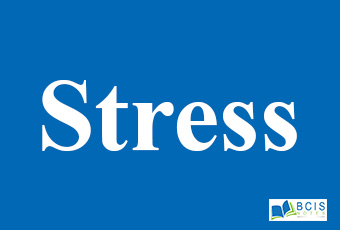
Stress
Stress is a dynamic condition in which an individual is confronted with an opportunity, constraints, or demand related to what he or she desires and for which the outcome is perceived to be both uncertain and important.
Concept of Stress:
It is considered to be a state of mind as well as body, created by certain biochemical reactions in the human body as well as psychological response in situations. It is a response to a sense of anxiety, tension, and depression.
Definitions by Moorhead and Griffin:
“Stress is a person’s adaptive response to a stimulus that places excessive psychological or physical demands on that person”.
What stress is not?
- Not simply anxiety
- not simply nervous tension, and
- it is not necessarily something damaging, bad or to be avoided
Types:
- eustress(positive) and
- distress(negative)
Causes of Stress:
four categories are:
- Extra-organizational causes
- Organizational causes
- Group causes
- Individual causes
A. Extra-organizational causes:
Taking an open system perspective of an organization, it is clear that job stress is not limited just to things that happen inside the organization, during working hours. environmental causes are as follows:
- social change
- globalization
- economic and financial conditions
- the Family
- residential or community
- relocation
- conditions, etc.
Example:
- Life’s changes may be slow or sudden(death of a loved one). These sudden changes have a very stressful impact on people.
- A sociological variable such as sex, gender, race, and class can also become stressors. As the workforce becomes increasingly diverse (heterogeneous) the chances for conflict also increases because of differences in beliefs, values, opportunities for rewards or promotions, etc.
B. Organizational causes:
Administrative policies and strategies |
Organizational structure and design |
Organizational processes |
Working conditions |
|
|
|
|
C. Group causes or stressors:
Groups have a high level of influence on individual member’s behavior and performance. These group stressors can be grouped into three types:
- Lack of group cohesiveness: Lack of cohesiveness creates conflict which serves as a potential stressor for the employees.
- Lack of social support: If we get social support, we feel good. If such kind is lacking, the same can cause the stress level high.
- Interpersonal/Interpersonal-group conflict: The incompatibility in terms of needs and values between co-workers usually creates interpersonal conflict. It includes inter-group conflict.
D. Individual stressors or causes:
They are:
- Role conflict and ambiguity: The roles are a set of expectations that other members have of an employee. The difference in expectations makes a conflict demands on the employees s/he experiences role conflict. Both role conflict and ambiguity cause considerable stress to the employee.
- Personal traits (type A and type B):
type A Profile |
type B Profile |
|
|
Techniques of Managing Stress:
Individual Level |
Organizational Level |
|
|
Consequences of Stress:
- Physical consequences
- Psychological consequences
- Behavioral consequences
Physical consequences:
It includes increased blood pressure, increased heart rate, muscular tension, and increased gastrointestinal disorders, etc.
Psychological consequences:
It includes anger, anxiety, depression, lowered self-esteem, poor intellectual functioning, and job dissatisfaction, etc.
Behavioral consequences:
It includes decreased performance, absenteeism, higher accidental rates, higher turnover rates, higher alcohol and other drug abuses, and difficulties in communication, etc.
| Physical consequences | Behavioral consequences | Psychological consequences |
|---|---|---|
|
|
|
You may also like Personality || Perception, Personality, and Learning.

Leave a Reply